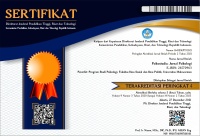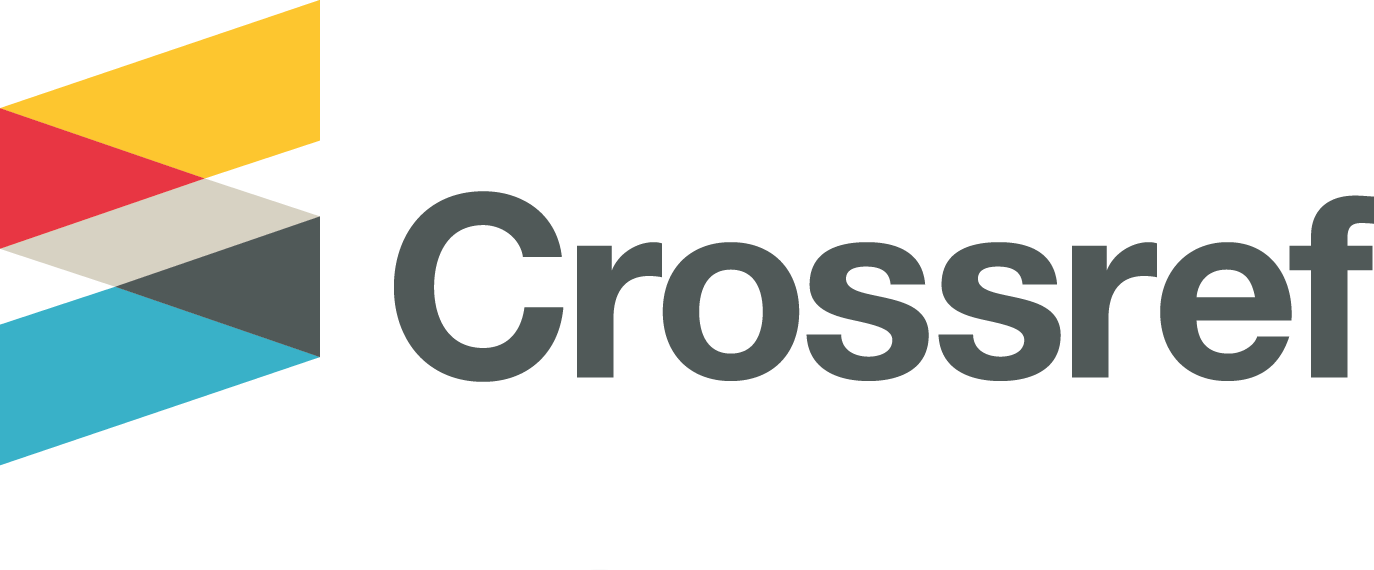Intuitive Thinking Style and Financial Risky Behaviour: The Mediating Role of Anticipated Emotions
Abstract
Financially risky behavior can negatively impact individuals' quality of life and well-being, particularly in the context of the ‘doom spending’ phenomenon and problematic online credit in Indonesia. This study aims to understand the relationship between Intuitive-Experiential thinking style and financially risky behavior, considering the role of anticipated emotions as a mediator. Using a non-experimental quantitative approach, this study involved 254 respondents aged 21–35 years. Data were analyzed using correlation and multiple regression (Hayes Process Model 4) techniques. The results indicated that the Intuitive-Experiential thinking style was not directly related to financially risky behavior; instead, anticipated emotions fully mediated this relationship. These findings highlight the importance of considering emotional factors in understanding risky financial behavior and their implications for policy interventions and financial literacy education in Indonesia.
Perilaku berisiko finansial dapat berdampak negatif terhadap kualitas hidup dan kesejahteraan individu, terutama dalam konteks fenomena ‘doom spending’ dan kredit online bermasalah di Indonesia. Penelitian ini bertujuan untuk memahami hubungan antara gaya berpikir Intuitif-Eksperiensial dan perilaku berisiko finansial, dengan mempertimbangkan peran emosi yang diantisipasi sebagai mediator. Penelitian ini melibatkan 254 responden berusia 21–35 tahun. Menggunakan pendekatan kuantitatif non-eksperimental, Data dianalisis menggunakan teknik korelasi dan regresi berganda dengan Hayes Process Model 4. Hasil penelitian menunjukkan bahwa gaya berpikir Intuitif-Eksperiensial tidak secara langsung berhubungan dengan perilaku berisiko finansial, melainkan hubungan tersebut dimediasi sepenuhnya oleh emosi yang diantisipasi. Temuan ini menegaskan pentingnya mempertimbangkan faktor emosi dalam memahami perilaku berisiko finansial serta implikasinya terhadap intervensi kebijakan dan edukasi literasi keuangan di Indonesia.
Keywords
Full Text:
FULL TEXTReferences
Albacete, N., & Lindner, P. (2013). Household Vulnerability in Austria–A Microeconomic Analysis based on the Household Finance and consumption survey. Financial Stability Report, 25, 57–73.
Alonso, D., & Fernández-Berrocal, P. (2003). Irrational decisions: Attending to numbers rather than ratios. Personality and Individual Differences, 35(7), 1537–1547. https://doi.org/10.1016/S0191-8869(02)00368-9
Alós-Ferrer, C., & Hügelschäfer, S. (2012). Faith in intuition and behavioral biases. Journal of Economic Behavior and Organization, 84(1), 182–192. https://doi.org/10.1016/j.jebo.2012.08.004
Anasthasya. (2023). Viral Nasabah Pinjol Bunuh Diri Tidak Kuat Diteror Debt Collector. Kompas.Com.
Broihanne, M. H., Merli, M., & Roger, P. (2014). Overconfidence, risk perception and the risk-taking behavior of finance professionals. Finance Research Letters, 11(2), 64–73. https://doi.org/https://doi.org/10.1016/j.frl.2013.11.002
Byrnes, J. P., Miller, D. C., & Schafer, W. D. (1999). Gender differences in risk taking: A meta-analysis. Psychological Bulletin, 125(3), 367.
Daghofer, F. (2007). Financial risk-taking on “Who Wants to Be a Millionaire”: A comparison between Austria, Germany, and Slovenia. International Journal of Psychology, 42(5), 317–330. https://doi.org/10.1080/00207590600852389
Danarti Hascaryani, T., & Maski, G. (2021). Heuristic, Herding and Disposition Effect in Investor’S Risk-Taking Behavior. International Journal of Economics, Business and Management Research, 5(12), 2021. www.ijebmr.com
Diener, E. (1984). Subjective well-being. Psychological Bulletin, 95(3), 542.
Diener, E., & Seligman, M. E. P. (2002). Research Report. 13(1), 81–84.
Diener, E., Wirtz, D., Tov, W., Kim-Prieto, C., Choi, D. won, Oishi, S., & Biswas-Diener, R. (2010). New well-being measures: Short scales to assess flourishing and positive and negative feelings. Social Indicators Research, 97(2), 143–156. https://doi.org/10.1007/s11205-009-9493-y
Dinç Aydemir, S., & Aren, S. (2017). Do the effects of individual factors on financial risk-taking behavior diversify with financial literacy? Kybernetes, 46(10), 1706–1734. https://doi.org/10.1108/K-10-2016-0281
Epstein, S. (1994). Integration of the Cognitive and the Psychodynamic Unconscious. American Psychologist, 49(8), 709–724. https://doi.org/10.1037/0003-066x.49.8.709
Epstein, S., Denes-Raj, V., & Pacini, R. (1995). The Linda Problem Revisited from the Perspective of Cognitive-Experiential Self-Theory. Personality and Social Psychology Bulletin, 21(11), 1124–1138. https://doi.org/10.1177/01461672952111001
Epstein, S., Pacini, R., Denes-Raj, V., & Heier, H. (1996). Individual Differences in Intuitive-Experiential and Analytical-Rational Thinking Styles. Journal of Personality and Social Psychology, 71(2), 390–405. https://doi.org/10.1037/0022-3514.71.2.390
Evans, J. S. B. T., & Stanovich, K. E. (2013). Dual-Process Theories of Higher Cognition: Advancing the Debate. Perspectives on Psychological Science, 8(3), 223–241. https://doi.org/10.1177/1745691612460685
Ferretti, R., Pancotto, F., & Rubaltelli, E. (2017). Persuasion in financial advertising: Behavioral or rational? Journal of Behavioral and Experimental Economics , 71, 26–30. https://doi.org/10.1016/j.socec.2017.08.002
Glaser, M., & Walther, T. (2013). Run, Walk, or Buy? Financial Literacy, Dual-Process Theory, and Investment Behavior. In SSRN Electronic Journal. https://doi.org/10.2139/ssrn.2336109
Gummer, T., Roßmann, J., & Silber, H. (2021). Using Instructed Response Items as Attention Checks in Web Surveys: Properties and Implementation. Sociological Methods and Research, 50(1), 238–264. https://doi.org/10.1177/0049124118769083
Gutiérrez-Nieto, B., Serrano-Cinca, C., & de la CuestaߚGonzález, M. (2017). A multivariate study of over-indebtedness’ causes and consequences. International Journal of Consumer Studies, 41(2), 188–198. https://doi.org/10.1111/ijcs.12324
Heriyantho, D. V., & Leon, F. M. (2022). Analisis Literasi Keuangan , Efikasi Diri , dan Perilaku Kredit Berisiko pada Mahasiswa di DKI Jakarta. Jurnal Pendidikan Tambusai, 6, 13202–13216.
Josef, A. K., Richter, D., Samanez-Larkin, G. R., Wagner, G. G., Hertwig, R., & Mata, R. (2016). Stability and change in risk-taking propensity across the adult life span. Journal of Personality and Social Psychology, 111(3), 430.
Kahneman, D., Lovallo, D., & Sibony, O. (2011). Before you make that big decision.
Kaufman, S. B. (2009). Faith in Intuition Is Associated With Decreased Latent Inhibition in a Sample of High-Achieving Adolescents. Psychology of Aesthetics, Creativity, and the Arts, 3(1), 28–34. https://doi.org/10.1037/a0014822
Kehr, F., Kowatsch, T., Wentzel, D., & Fleisch, E. (2015). Thinking Styles and Privacy Decisions: Need for Cognition, Faith into Intuition, and the Privacy Calculus. 12th International Conference on Wirtschaftsinformatik, 1–14. http://cocoa.ethz.ch/downloads/2014/11/2086_WI2015 Paper Privacy v1.0_camera_ready.pdf
Keller, J., Bohner, G., & Erb, H.-P. (2000). Intuitive und heuristische Urteilsbildung – verschiedene Prozesse ? Präsentation einer deutschen Fassung des ”Rational-Experiential Inventory” sowie neuer Selbstberichtskalen zur Heuristiknutzung. Zeitschrift Für Sozialpsychologie, 31(2), 87–101. https://doi.org/10.1024//0044-3514.31.2.87
Khadafi, M. (2024). Warga RI Makin Doyan Ngutang di Paylater, Pinjaman Tembus Rp 6 Triliun. CNBC Indonesia.
Khan, M. S. R., Rabbani, N., & Kadoya, Y. (2021). Can Financial Literacy Explain Lack of Investment in Risky Assets in Japan? Sustainability, 13(22), 12616. https://doi.org/10.3390/su132212616
Kirkebøen, G., & Nordbye, G. H. H. (2017). Intuitive choices lead to intensified positive emotions: An overlooked reason for “intuition bias”? Frontiers in Psychology, 8(NOV), 1–11. https://doi.org/10.3389/fpsyg.2017.01942
Kotabe, H. P., Righetti, F., & Hofmann, W. (2019). How anticipated emotions guide self-control judgments. Frontiers in Psychology, 10, 1614.
Krava, L., Ayal, S., & Hochman, G. (2021). Time Is Money: The Effect of Mode-of-Thought on Financial Decision-Making. Frontiers in Psychology, 12(September). https://doi.org/10.3389/fpsyg.2021.735823
Kusev, P., Purser, H., Heilman, R., Cooke, A. J., Van Schaik, P., Baranova, V., Martin, R., & Ayton, P. (2017). Understanding risky behavior: The influence of cognitive, emotional and hormonal factors on decision-making under risk. Frontiers in Psychology, 8(FEB), 1–10. https://doi.org/10.3389/fpsyg.2017.00102
Lieberman, J. D. (2002). Head over the heart or heart over the head? Cognitive experiential self-theory and extralegal heuristics in juror decision making. Journal of Applied Social Psychology, 32(12), 2526–2553. https://doi.org/10.1111/j.1559-1816.2002.tb02755.x
Loewenstein, G. F., & O’Donoghue, T. (2011). Animal Spirits: Affective and Deliberative Processes in Economic Behavior. SSRN Electronic Journal, August. https://doi.org/10.2139/ssrn.539843
Loo, R. (2002). A caveat on using single-item versus multiple-item scales. Journal of Managerial Psychology, 17(1), 68–75. https://doi.org/10.1108/02683940210415933
Mellers, B. A., & McGraw, A. P. (2001). Anticipated emotions as guides to choice. Current Directions in Psychological Science, 10(6), 210–214.
Moreira Costa, V., De Sá Teixeira, N. A., Cordeiro Santos, A., & Santos, E. (2021). When more is less in financial decision-making: financial literacy magnifies framing effects. Psychological Research, 85(5), 2036–2046. https://doi.org/10.1007/s00426-020-01372-7
Mukharomah, Kurniawan, M. R., & Noorbaiti. (2023). Pengaruh Literasi Keuangan Terhadap Perilaku Kredit Berisiko Yang Dimediasi Oleh Efikasi Diri Pada Mahasiswa Di Kota Surakarta. Benefit: Jurnal Manajemen Dan Bisnis, 8, 49–58. https://doi.org/10.23917/benefit.v8i1.2056
Nan, X. (2009). Emotional responses to televised PSAs and their influence on persuasion: An investigation of the moderating role of faith in intuition. Communication Studies, 60(5), 426–442. https://doi.org/10.1080/10510970903260236
Norris, P., & Epstein, S. (2011). An experiential thinking style: Its facets and relations with objective and subjective criterion measures. Journal of Personality, 79(5), 1043–1080. https://doi.org/10.1111/j.1467-6494.2011.00718.x
OJK. (2019). Syarat Memiliki Kartu Kredit Menurut Ketentuan Bank Indonesia. Otoritas Jasa Keuangan. https://sikapiuangmu.ojk.go.id/FrontEnd/CMS/Article/340
Pieters, R., & Zeelenberg, M. (2007). A theory of regret regulation 1.1. Journal of Consumer Psychology, 17(1), 29–35. https://doi.org/10.1207/s15327663jcp1701_6
Pollai, M., Hoelzl, E., Hahn, L., & Hahn, A. (2011). The Influence of Anticipated Emotions on Consumer Decisions Examining the Role of Product Type and Belief in Adaptation. Zeitschrift Für Psychologie/Journal of Psychology, 219, 238–245. https://doi.org/10.1027/2151-2604/a000078
Pramudatama, S. B. (2024). Fenomena Doom Spending yang Banyak Dilakukan Gen Z, Simak Penjelasannya! Liputan6.
Riquelme, H. E. (2020). Anticipated emotions and their effects on risk and opportunity evaluations. 312–335.
Rumondang, N. H., Rustam, M., & Sianipar, A. (2025). Anticipatory Emotion and Risky Financial Behavior : The Moderating Role of Regulatory Focus. 12(April), 46–61. https://doi.org/10.20527/ecopsy.2025.12.004
Sanker, S. (2016). The impact of novice entrepreneurs ’ faith in intuition on the entrepreneurial decision-making process. 7th IBA Bachelor Thesis Conference, 28.
Scott, R., & Loewenstein, G. (2008). The Role of Emotion in Economic Behaviour. Handbook of Emotions, 138–156.
Skagerlund, K., Forsblad, M., Slovic, P., & Västfjäll, D. (2020). The Affect Heuristic and Risk Perception – Stability Across Elicitation Methods and Individual Cognitive Abilities. Frontiers in Psychology, 11(June), 1–10. https://doi.org/10.3389/fpsyg.2020.00970
Slovic, P., Finucane, M. L., Peters, E., & MacGregor, D. G. (2007). The affect heuristic. European Journal of Operational Research, 177(3), 1333–1352. https://doi.org/10.1016/j.ejor.2005.04.006
Slovic, P., Peters, E., Finucane, M. L., & MacGregor, D. G. (2005). Affect, risk, and decision making. Health Psychology, 24(4 SUPPL.), 35–40. https://doi.org/10.1037/0278-6133.24.4.S35
Spence, A., & Townsend, E. (2008). Spontaneous evaluations: Similarities and differences between the affect heuristic and implicit attitudes. Cognition and Emotion, 22(1), 83–93. https://doi.org/10.1080/02699930701298432
Stevenson, S. S., & Hicks, R. E. (2016). Trust Your Instincts: The Relationship Between Intuitive Decision Making And Happiness. European Scientific Journal, ESJ, 12(11), 463. https://doi.org/10.19044/esj.2016.v12n11p463
Sweet, E., Nandi, A., Adam, E. K., & McDade, T. W. (2013). The high price of debt: Household financial debt and its impact on mental and physical health. Social Science & Medicine, 91, 94–100.
Tomljenovic, H., Bubic, A., & Erceg, N. (2020). It just doesn’t feel right–the relevance of emotions and intuition for parental vaccine conspiracy beliefs and vaccination uptake. Psychology and Health, 35(5), 538–554. https://doi.org/10.1080/08870446.2019.1673894
Veilleux, J. C., Lankford, N. M., Hill, M. A., Skinner, K. D., Chamberlain, K. D., Baker, D. E., & Pollert, G. A. (2020). Affect balance predicts daily emotional experience. Personality and Individual Differences, 154(October 2019), 109683. https://doi.org/10.1016/j.paid.2019.109683
Zeelenberg, M. (1999). Anticipated regret, expected feedback and behavioral decision making. Journal of Behavioral Decision Making, 12(2), 93–106. https://doi.org/10.1002/(SICI)1099-0771(199906)12:2<93::AID-BDM311>3.0.CO;2-S
Zhang, B., & Shou, Y. (2022). Immediate emotions and subjective stakes in risky decision-making under uncertainty. Anxiety, Stress and Coping, 35(6), 649–661. https://doi.org/10.1080/10615806.2021.1994143
DOI: http://dx.doi.org/10.30872/psikostudia.v14i4.20509
Refbacks
- There are currently no refbacks.
Copyright (c) 2025 Theodora Maharani, Miriam Rustam, Agnes Sianipar

This work is licensed under a Creative Commons Attribution-ShareAlike 4.0 International License.
Psikostudia: Jurnal Psikologi is indexed by :
PSIKOSTUDIA: Jurnal Psikologi Published by Faculty of Social and Political Siences, University of Mulawarman, Samarinda, East Kalimantan and This work is licensed under a Creative Commons Attribution-ShareAlike 4.0 International License.
_________________________________________
PSIKOSTUDIA: Jurnal Psikologi
Department of Psychology
Faculty of Social and Political Siences, University of Mulawarman
Jl. Muara Muntai Kampus Gn. Kelua Samarinda 75411
Phone: +62 813 35350368
E-Mail: psikostudia@fisip.unmul.ac.id




















